Assessing Benzene and TVOC Pollution and the Carcinogenic and Noncarcinogenic Risks to Workers in an Industrial Plant in Southeastern Romania
Abstract
1. Introduction
2. Study area and Methodology
2.1. Study Site
2.2. Data Series
2.3. Data Analysis
- (1)
- Compute the basic statistics (mean, minimum, maximum, coefficient of variation, and skewness) and plot the histograms and boxplots to determine the series characteristics and emphasize the shapes of the series distribution and possible outliers.
- (2)
- Apply the Anderson–Darling (AD) test [60] to test the hypothesis that the series is Gaussian against the hypothesis that the series is not normally distributed.
- (3)
- Apply the Fligner–Killeen (KF) test [61] to check the homoskedasticity of each time series. The null (alternative) hypothesis is that the series is homoskedastic (heteroskedastic). The choice of this nonparametric test was based on the research of Conover et al. [62], which shows that this test is better than the alternatives in terms of power and when the normality hypothesis is not satisfied.
- (4)
- (5)
- Apply the KPSS test [65] to test the null hypothesis of the series trend (or level) stationarity against its nonstationarity.
- (6)
- Test the hypothesis that the series has no change points (breakpoint) against the hypothesis that it has at least one by performing the Buishand [66], Pettitt [67], Lee and Heghinian [68] tests, and Hubert segmentation procedure [69]. A change point appears when the series changes the mean, variance, or distribution from which it arose. The first three tests can determine only the most probable breakpoint. Moreover, the Buishand and Lee and Heghinian tests can be performed only if the series is Gaussian. If the series fails the normality test but can reach it by a transformation, the changepoint tests are run on the transformed series; otherwise, only the Pettitt and Hubert procedures can be performed. KhronoStat 1.01 (Hydrosciences Montpellier, France) [70] was utilized to conduct the tests.
- (7)
- Apply the Kruskal–Wallis (K-W) test [71] to test if the series in a group originate from the same distribution against the alternative that at least one comes from a different distribution. When the null hypothesis was rejected, the post-hoc Dunn’s test [72], with the adjustment proposed by Hochberg [73], was run.
2.4. Modeling the VOC Series
2.5. Health Risk Assessment
- -
- (μg/m3) is the average daily concentration of VOCs;
- -
- is the daily exposure time, considered 8 h/day for all workers;
- -
- EF is the exposure frequency. EF has the following values function of the worker categories: (1) 350 days/year, (2) 340 days/year, (3) 325 days/year, (4) 340 days/year.
- -
- ED is the exposure duration. ED has the following values function of the worker categories: (1) 5 years, (2) 10 years, (3) 15 years, (4) 25 years.
- -
- is the average exposure time to noncarcinogenic risk, estimated at 74.8 years;
- -
- (μg/m3) represents the reference concentration of VOC species for the noncarcinogenic risk assessment.
- -
- , ET, EF, and ED have the same meaning and values as in Equation (3).
- -
- is the average time under exposure to carcinogenic risk, estimated at 70 years.
- -
- represents the inhalation unit risk of VOC species for carcinogenic risk assessment. A cumulative value of = 2.5 × 10−6 (μg/m3)−1 was considered in the computation of LCR for TCOVs.
3. Results and Discussion
3.1. Results of the Statistical Analysis
3.2. Models for the Benzene and TVOC Series
3.3. Health Risk Indicators
3.4. Discussions
4. Conclusions
Author Contributions
Funding
Institutional Review Board Statement
Informed Consent Statement
Data Availability Statement
Conflicts of Interest
References
- Brinkmann, T.; Both, R.; Scalet, B.M.; Roudier, S.; Delgado Sancho, L. EUR 29261 EN; JRC Reference Report on Monitoring of Emissions to Air and Water from IED Installations. Publications Office of the European Union: Luxembourg, 2018; pp. 66–68. Available online: https://eippcb.jrc.ec.europa.eu/sites/default/files/2019-12/ROM_2018_08_20.pdf (accessed on 21 April 2023).
- Rovira, J.; Nadal, M.; Schuhmacher, M.; Domingo, J.L. Environmental impact and human health risks of air pollutants near a large chemical/petrochemical complex: Case study in Tarragona, Spain. Sci. Total Environ. 2021, 787, 147550. [Google Scholar] [CrossRef] [PubMed]
- Ancione, G.; Lisi, R.; Milazzo, M.F. Human health risk associated with emissions of volatile organic compounds due to the ship-loading of hydrocarbons in refineries. Atmos. Pollut. Res. 2021, 12, 432–442. [Google Scholar] [CrossRef]
- Ragothaman, A.; Anderson, W.A. Air Quality Impacts of Petroleum Refining and Petrochemical Industries. Environments 2017, 4, 66. [Google Scholar] [CrossRef]
- Sanda, M.; Dunea, D.; Iordache, S.; Pohoata, A.; Glod-Lendvai, A.-M.; Onutu, I.A. Three-Year Analysis of Toxic Benzene Levels and Associated Impact in Ploieşti City, Romania. Toxics 2023, 11, 748. [Google Scholar] [CrossRef] [PubMed]
- Bărbulescu, A.; Barbeş, L. Statistical Assessment and Modeling of Benzene Level in Atmosphere in Timiş County, Romania. Int. J. Environ. Sci. Technol. 2022, 19, 817–828. [Google Scholar] [CrossRef]
- Bărbulescu, A.; Barbeş, L. Mathematical modeling of sulfur dioxide concentration in the western part of Romania. J. Environ. Manag. 2017, 204, 825–830. [Google Scholar] [CrossRef]
- Bărbulescu, A.; Barbeş, L. Modeling the carbon monoxide dissipation in Timisoara, Romania. J. Environ. Manag. 2017, 204, 831–838. [Google Scholar] [CrossRef]
- Chiritescu, R.-V.; Luca, E.; Iorga, G. Observational study of major air pollutants over urban Romania in 2020 in comparison with 2019. Rom. Rep. Phys. 2024, 76, 702. Available online: https://rrp.nipne.ro/IP/AP718.pdf (accessed on 25 February 2024).
- Monod, A.; Sive, B.C.; Avino, P.; Chen, T.; Blake, D.R.; Sherwood Rowland, F. Monoaromatic compounds in ambient air of various cities: A focus on correlations between the xylenes and ethylbenzene. Atmos. Environ. 2001, 35, 135–149. [Google Scholar] [CrossRef]
- Bărbulescu, A.; Barbeş, L. Characterization of the Concentrations of Volatile Organic Compounds in the Romanian Littoral using General Regression Neural Networks: A Case Study. Anal. Lett. 2016, 49, 387–399. [Google Scholar] [CrossRef]
- Sadeghi, B.; Pouyaei, A.; Choi, Y.; Rappenglueck, B. Influence of seasonal variability on source characteristics of VOCs at Houston industrial area. Atmos. Environ. 2022, 277, 119077. [Google Scholar] [CrossRef]
- Huang, Y.; Che, X.; Jin, D.; Xiu, G.; Duan, L.; Wu, Y.; Gao, S.; Duan, Y.; Fu, Q. Mobile monitoring of VOCs and source identification using two direct-inlet MSs in a large fine and petroleum chemical industrial park. Sci. Total Environ. 2022, 823, 153615. [Google Scholar] [CrossRef]
- Nadal, M.; Cadiach, O.; Kumar, V.; Poblet, P.; Mari, M.; Schuhmacher, M.; Domingo, J.L. Health Risk Map of a Petrochemical Complex through GIS-Fuzzy Integration of Air Pollution Monitoring Data. Hum. Ecol. Risk Assess. 2011, 17, 873–891. [Google Scholar] [CrossRef]
- Baltrenas, P.; Baltrenaite, E.; Sereviciene, V.; Pereira, P. Atmospheric BTEX concentrations in the vicinity of the crude oil refinery of the Baltic region. Environ. Monit. Assess. 2011, 182, 115–127. [Google Scholar] [CrossRef] [PubMed]
- Forouzanfar, M.H.; Afshin, A.; Alexander, L.T.; Anderson, H.R.; Bhutta, Z.A.; Biryukov, S.; Brauer, M.; Brunett, R.; Cercy, K.; Charlson, F.; et al. Global, regional, and national comparative risk assessment of 79 behavioural, environmental and occupational, and metabolic risks or clusters of risks, 1990–2015: A systematic analysis for the Global Burden of Disease Study 2015. Lancet 2016, 388, 1659–1724. [Google Scholar] [CrossRef] [PubMed]
- Antonescu, N.N.; Stănescu, D.P.; Calotă, R. CO2 Emissions Reduction through Increasing H2 Participation in Gaseous Combustible—Condensing Boilers Functional Response. Appl. Sci. 2022, 12, 3831. [Google Scholar] [CrossRef]
- Shaddick, G.; Thomas, M.L.; Mudu, P.; Ruggeri, G.; Gumy, S. Half the world’s population are exposed to increasing air pollution. NPJ Clim. Atmos. Sci. 2020, 3, 23. [Google Scholar] [CrossRef]
- Dhimal, M.; Chirico, F.; Bista, B.; Sharma, S.; Chalise, B.; Dhimal, M.L.; Ilesanmi, O.S.; Trucillo, P.; Sofia, D. Impact of Air Pollution on Global Burden of Disease in 2019. Processes 2021, 9, 1719. [Google Scholar] [CrossRef]
- Saikomol, S.; Thepanondh, S.; Laowagul, W.; Malakan, W.; Keawboonchu, J.; Kultan, V. Characteristics and dispersion modeling of VOCs emission released from the tank farm of petroleum refinery complex. Environ. Asia 2021, 14, 1–12. [Google Scholar]
- Cheng, S.; Zhang, J.; Wang, Y.; Zhang, D.; Teng, G.; Chang-Chien, G.P.; Huang, Q.; Zhang, Y.B.; Yan, P. Global Research Trends in Health Effects of Volatile Organic Compounds during the Last 16 Years: A Bibliometric Analysis. Aerosol Air Qual. Res. 2019, 19, 1834–1843. [Google Scholar] [CrossRef]
- Cao, L.; Men, Q.; Zhang, Z.; Yue, H.; Cui, S.; Huang, X.; Zhang, Y.; Wang, J.; Chen, M.; Li, H. Significance of Volatile Organic Compounds to Secondary Pollution Formation and Health Risks Observed during a Summer Campaign in an Industrial Urban Area. Toxics 2024, 12, 34. [Google Scholar] [CrossRef]
- Collins, J.J.; Ireland, B.; Buckley, C.F.; Shepperly, D. Lymphohaematopoeitic cancer mortality among workers with benzene exposure. Occup. Environ. Med. 2003, 60, 676–679. [Google Scholar] [CrossRef]
- Snyder, R. Leukemia and benzene. Int. J. Environ. Res. Public Health 2012, 9, 2875–2893. [Google Scholar] [CrossRef]
- Falzone, L.; Marconi, A.; Loreto, C.; Franco, S.; Demetrios, A.; Libra, M. Occupational exposure to carcinogens: Benzene, pesticides and fibers (Review). Molec. Med. Rep. 2016, 14, 4467–4474. [Google Scholar] [CrossRef]
- Hansen, J. Elevated risk for male breast cancer after occupational exposure to gasoline and vehicular combustion products. Am. J. Ind. Med. 2000, 37, 349–352. [Google Scholar] [CrossRef]
- Rennix, C.P.; Quinn, M.M.; Amoroso, P.J.; Eisen, E.A.; Wegman, D.H. Risk of breast cancer among enlisted army women occupationally exposed to volatile organic compounds. Am. J. Ind. Med. 2005, 48, 157–167. [Google Scholar] [CrossRef] [PubMed]
- Seniori Costantini, A.; Gorini, G.; Consinni, D.; Miligi, L.; Giovannetti, L.; Quinn, M. Exposure to benzene and risk of breast cancer among shoe factory workers in Italy. Tumori 2009, 95, 8–12. [Google Scholar] [CrossRef]
- Ruckart, P.Z.; Bove, F.J.; Shanley, E.; Maslia, M. Evaluation of contaminated drinking water and male breast cancer at Marine Corps Base Camp Lejeune, North Carolina: A case control study. Environ. Health 2015, 14, 74. [Google Scholar] [CrossRef] [PubMed]
- Blair, A.; Marrett, L.; Beane Freeman, L. Occupational cancer in developed countries. Environ. Health 2011, 10 (Suppl. S1), S9. [Google Scholar] [CrossRef] [PubMed]
- Lan, Q.; Zhang, L.; Li, G.; Vermeulen, R.; Weinberg, R.S.; Dosemeci, M.; Rappaport, S.M.; Shen, M.; Alter, B.P.; Wu, Y.; et al. Hematotoxicity in workers exposed to low levels of benzene. Science 2004, 306, 1774–1776. [Google Scholar] [CrossRef] [PubMed]
- Hussain, M.S.; Gupta, G.; Mishra, R.; Patel, N.; Gupta, S.; Alzarea, S.I.; Kazmi, I.; Kumbhar, P.; Disouza, J.; Dureja, H.; et al. Unlocking the secrets: Volatile Organic Compounds (VOCs) and their devastating effects on lung cancer. Pathol. Res. Pract. 2024, 255, 155–157. [Google Scholar] [CrossRef]
- Boffetta, P.; Jourenkova, N.; Gustavsson, P. Cancer risk from occupational and environmental exposure to polycyclic aromatic hydrocarbons. Cancer Caus. Control 1997, 8, 444–472. [Google Scholar] [CrossRef]
- Shala, N.K.; Stenehjem, J.S.; Babigumira, R.; Liu, F.-C.; Berge, L.A.M.; Silverman, D.T.; Friesen, M.C.; Rothman, N.; Lan, Q.; Hosgood, H.D.; et al. Exposure to benzene and other hydrocarbons and risk of bladder cancer among male offshore petroleum workers. Br. J. Cancer 2023, 129, 838–851. [Google Scholar] [CrossRef] [PubMed]
- 6 Volatile Organic Compounds (VOCs): Risk Assessment of Mixtures of Potentially Carcinogenic Chemicals. Available online: https://www.ncbi.nlm.nih.gov/books/NBK218904/ (accessed on 18 February 2024).
- Guo, H.; Lee, S.C.; Chan, L.Y.; Li, W.M. Risk assessment of exposure to volatile organic compounds in different indoor environments. Environ. Res. 2004, 94, 57–66. [Google Scholar] [CrossRef] [PubMed]
- Huff, J.; Chan, P.; Melnick, R. Clarifying carcinogenicity of ethylbenzene. Regul. Toxicol. Pharmacol. 2010, 58, 167–172. [Google Scholar] [CrossRef] [PubMed]
- Ethylbenzene. Available online: https://www.epa.gov/sites/default/files/2016-09/documents/ethylbenzene.pdf (accessed on 19 February 2024).
- Tabari, M.R.R.; Sabzalipour, S.; Peyghambarzadeh, S.M.; Jalilzadeh, R. Dispersion of volatile organic compounds in the vicinity of petroleum products storage tanks. Environ. Eng. Manag. J. 2021, 20, 1119–1136. [Google Scholar]
- Barthe, P.; Chaugny, M.; Roudier, S.; Delgado Sancho, L. EUR 27140EN; Best Available Techniques (BAT) Reference Document for the Refining of Mineral Oil and Gas. Publications Office of the European Union: Luxembourg, 2015; Volume 1, pp. 141–142. Available online: https://eippcb.jrc.ec.europa.eu/sites/default/files/2019-11/REF_BREF_2015.pdf (accessed on 21 April 2023).
- Feng, X.; Xiao, A.; Jia, R.; Zhu, S.; Gao, S.; Li, B.; Shi, N.; Zou, B. Emission characteristics and associated assessment of volatile organic compounds from process units in a refinery. Environ. Pollut. 2020, 265, 115026. [Google Scholar] [CrossRef] [PubMed]
- Daginnus, K.; Marty, T.; Trotta, N.V.; Brinkmann, T.; Whitfield, A.; Roudier, S. Best Available Techniques (BAT) Reference Document for Common Waste Gas Management and Treatment Systems in the Chemical Sector: Industrial Emissions Directive 2010/75/EU (Integrated Pollution Prevention and Control), European Commission, Joint Research Centre, Publications Office of the European Union. 2023. Available online: https://data.europa.eu/doi/10.2760/220326 (accessed on 20 July 2023).
- Lv, D.; Lu, S.; Tan, X.; Shao, M.; Xie, S.; Wang, L. Source profiles, emission factors and associated contributions to secondary pollution of volatile organic compounds (VOCs) emitted from a local petroleum refinery in Shandong. Environ. Pollut. 2021, 274, 116589. [Google Scholar] [CrossRef]
- Roveda, L.; Polvara, E.; Invernizzi, M.; Capelli, L.; Sironi, S. Definition of an Emission Factor for VOC Emitted from Italian and European Refineries. Atmosphere 2020, 11, 564. [Google Scholar] [CrossRef]
- Choi, K.; Chong, K. Modified Inverse Distance Weighting Interpolation for Particulate Matter Estimation and Mapping. Atmosphere 2022, 13, 846. [Google Scholar] [CrossRef]
- Kianisadr, M.; Ghaderpoori, M.; Jafari, A.; Kamarehie, B.; Karami, M. Zoning of air quality index (PM10 and PM2.5) by Arc-GIS for Khorramabad city, Iran. Data Brief 2018, 19, 1131–1141. [Google Scholar] [CrossRef]
- Hong, N.; Liu, A.; Zhu, P.; Zhao, X.; Guan, Y.; Yang, M.; Wang, H. Modelling benzene series pollutants (BTEX) build-up loads on urban roads and their human health risks: Implications for stormwater reuse safety. Ecotox. Environ. Safe. 2018, 164, 234–242. [Google Scholar] [CrossRef] [PubMed]
- Dumitru, A.; Olaru, E.-A.; Dumitru, M.; Iorga, G. Assessment of air pollution by aerosols over a coal open-mine influenced region in southwestern Romania. Rom. J. Phys. 2024, 69, 801. Available online: https://rjp.nipne.ro/accpaps/50040F92CBD2CBBC73AD5329374F175B49326E0A.pdf (accessed on 25 February 2024).
- Bărbulescu, A.; Dumitriu, C.S.; Ilie, I.; Barbeș, S.B. Influence of Anomalies on the Models for Nitrogen Oxides. Atmosphere 2022, 13, 558. [Google Scholar] [CrossRef]
- Bărbulescu, A.; Barbeş, L.; Nazzal, Y. New model for inorganic pollutants dissipation on the Northern part of the Romanian Black Sea coast. Rom. J. Phys. 2018, 63, 806. [Google Scholar]
- Bărbulescu, A.; Barbeş, L. Models for pollutants’ correlation in the Romanian littoral. Rom. Rep. Phys. 2014, 66, 1189–1199. [Google Scholar]
- KPMG Rompetrol Refinery–Internal Site and Environmental Report, August. 2017. Available online: https://www.anpm.ro/documents/840114/32994861/Raport+de+Amplasament_Rompetrol+Rafinare+SA_2017.pdf/aef86454-715c-4fdb-9913-bdf3ef25ae87 (accessed on 20 September 2023). (In Romanian).
- EN 15446:2008; Fugitive and Diffuse Emissions of Common Concern to Industry Sectors-Measurement of Fugitive Emission of Vapours Generating from Equipment and Piping Leaks. CEN: Brussels, Belgium, 2008. Available online: https://standards.iteh.ai/catalog/standards/cen/ca30d7f9-a531-46eb-9ce1-5786a5270bf1/en-15446-2008 (accessed on 20 November 2023).
- Directive 2010/75/EU of the European Parliament and of the COUNCIL of 24 November 2010 on Industrial Emissions (Integrated Pollution Prevention and Control). Available online: https://eur-lex.europa.eu/search.html?lang=ro&text=Directive+2010%2F75%2FUE&qid=1700600769627&type=quick&scope=EURLEX&locale=en (accessed on 20 November 2023).
- The Law 104/2011 on the Environmental Air Quality. Available online: https://mmediu.ro/app/webroot/uploads/files/2011-12-29_legislatie_calitate_aer_legea104din2011calitate%20aer.pdf (accessed on 20 September 2023). (In Romanian).
- Directive 2001/81/EC of the European Parliament and of the Council of 23 October 2001 on National Emission Ceilings for Certain Atmospheric Pollutants. Available online: https://eur-lex.europa.eu/legal-content/EN/TXT/PDF/?uri=CELEX:32001L0081 (accessed on 15 November 2023).
- Romanian Law 264 of 20 December 2017, Regarding the Establishment of Technical Requirements for Limiting the Emissions of Volatile Organic Compounds (VOCs) Resulting from the Storage and Distribution of Gasoline from Terminals to Gasoline Stations, as well as during the Refueling of Vehicles at Gas Stations. Available online: https://legislatie.just.ro/Public/DetaliiDocument/196201 (accessed on 20 November 2023). (In Romanian).
- EU 2022. Commission Implementing Decision (EU) 2022/2427 of 6 December 2022 Establishing the Best Available Techniques (BAT) Conclusions, under Directive 2010/75/EU of the European Parliament and of the Council on Industrial Emissions, for Common Waste Gas Management and Treatment Systems in the Chemical Sector. Available online: https://eur-lex.europa.eu/legal-content/RO/TXT/?uri=CELEX%3A32022D2427 (accessed on 1 December 2023).
- European Parliament and Council Directive 94/63/EC of 20 December 1994 on the Control of Volatile Organic Compound (VOC) Emissions Resulting from the Storage of Petrol and Its Distribution from Terminals to Service Stations. Available online: https://eur-lex.europa.eu/legal-content/EN/TXT/PDF/?uri=CELEX:01994L0063-20190726&qid=1700602119732 (accessed on 20 November 2023).
- Anderson, T.W.; Darling, D.A. Asymptotic theory of certain “goodness of fit” criteria based on stochastic processes. Ann. Math. Stat. 1952, 23, 193–212. [Google Scholar] [CrossRef]
- Fligner, M.A.; Killeen, T.J. Distribution-free two-sample tests for scale. J. Am. Stat. Assoc. 1976, 71, 210–213. [Google Scholar] [CrossRef]
- Kendall, M.G. Rank Correlation Methods; Oxford University Press: New York, NY, USA, 1975. [Google Scholar]
- Sen, P.K. Estimates of the regression coefficient based on Kendall’s tau. J. Am. Stat. Assoc. 1968, 63, 1379–1389. [Google Scholar] [CrossRef]
- Conover, W.J.; Johnson, M.E.; Johnson, M.M. A comparative study of tests for homogeneity of variances, with applications to the outer continental shelf biding data. Technometrics 1981, 23, 351–361. [Google Scholar] [CrossRef]
- Kwiatkowski, D.; Phillips, P.C.B.; Schmidt, P.; Shin, Y. Testing the null hypothesis of stationarity against the alternative of a unit root. J. Econ. 1992, 54, 159–178. [Google Scholar] [CrossRef]
- Buishand, T.A. Some Methods for Testing the Homogeneity of Rainfall Records. J. Hydrol. 1982, 58, 11–27. [Google Scholar] [CrossRef]
- Pettitt, A.N. A non-parametric approach to the change-point problem. J. Royal Stat. Soc. Ser. C (Appl. Stat.) 1979, 28, 126–135. [Google Scholar] [CrossRef]
- Lee, A.F.; Heghinian, S.M. A Shift of the Mean Level in a Séquence of Independent Normal Random Variables: A Bayesian Approach. Technometrics 1977, 19, 503–506. [Google Scholar]
- Hubert, P. The segmentation procedure as a tool for discrete modeling of hydrometeorological regimes. Stoch. Env. Res. Risk 2000, 14, 297–304. [Google Scholar] [CrossRef]
- KhronoStat 1.01. Available online: http://www.hydrosciences.org/index.php/2020/09/04/khronostat/ (accessed on 28 November 2023).
- Kruskal, W.H.; Wallis, W.A. Use of ranks in one-criterion variance analysis. J. Am. Stat. Assoc. 1952, 47, 583–621. [Google Scholar] [CrossRef]
- Dunn, O.J. Multiple comparisons using rank sums. Technometrics 1964, 6, 241–252. [Google Scholar] [CrossRef]
- Hochberg, Y. A sharper Bonferroni procedure for multiple tests of significance. Biometrika 1988, 75, 800–802. [Google Scholar] [CrossRef]
- Lenox, M.J.; Haimes, Y.Y. The constrained extremal distribution selection method. Risk Anal. 1996, 16, 161–176. [Google Scholar] [CrossRef]
- Su, F.-C.; Jia, C.; Batterman, S. Extreme value analyses of VOC exposures and risks: A comparison of RIOPA and NHANES datasets. Atmos. Environ. 2021, 62, 97–106. [Google Scholar] [CrossRef]
- Embrechts, P.; Resnick, S.; Samorodnitsky, G. Living on the edge. Risk Mag. 1998, 11, 96–100. [Google Scholar]
- Davison, A.; Huser, R. Statistics of extremes. Annu. Rev. Stat. Appl. 2015, 2, 203–235. [Google Scholar] [CrossRef]
- Bommier, E. Peaks-Over-Threshold Modelling of Environmental Data. 2014. Available online: https://www.diva-portal.org/smash/get/diva2:760802/FULLTEXT01.pdf (accessed on 10 December 2023).
- Hosking, J.R.M. L-moments: Analysis and estimation of distributions using linear combinations of order statistics. J. Royal Stat. Soc. 1990, 52, 105–124. [Google Scholar] [CrossRef]
- Hosking, J.R.M.; Wallis, J.R. Regional Frequency Analysis. An Approach Based on L-Moments; Cambridge University Press: New York, NY, USA, 1997. [Google Scholar]
- Introduction to Extreme Value Analysis in R—Part 3: Peak over Threshold Approach. Available online: https://www.gis-blog.com/eva-intro-3/ (accessed on 10 December 2023).
- Vezzoli, R. A Brief Introduction to the Concept of Return Period for Univariate Variables. Available online: https://www.cmcc.it/wp-content/uploads/2012/10/rp0139-isc-09-2012.pdf (accessed on 20 February 2024).
- Generalized Extreme Value Distribution and Calculation of Return Value. Available online: https://gmao.gsfc.nasa.gov/research/subseasonal/atlas/GEV-RV-html/GEV-RV-description.html (accessed on 20 February 2024).
- Cooley, D. Return Periods and Return Levels Under Climate Change. In Extremes in a Changing Climate; AghaKouchak, A., Easterling, D., Hsu, K., Schubert, S., Sorooshian, S., Eds.; Springer: Dordrecht, The Netherlands, 2013; pp. 97–114. [Google Scholar]
- United States Environmental Protection Agency. Risk Assessment for Carcinogenic Effects. Table 1. Prioritized Chronic Dose-Response Values for Screening Risk Assessments. 2018. Available online: https://www.epa.gov/fera/risk-assessment-carcinogenic-effects (accessed on 15 January 2024).
- United States Environmental Protection Agency. Exposure Factors Interactive Resource for Scenarios Tool (ExpoFIRST). Available online: https://www.epa.gov/expobox/exposure-factors-interactive-resource-scenarios-tool-expofirst (accessed on 15 January 2024).
- EPA IRIS (United States Environmental Protection Agency Integrated Risk Information System) 2020. IRIS Assessments. Available online: https://cfpub.epa.gov/ncea/iris_drafts/atoz.cfm?list_type=alpha (accessed on 15 January 2024).
- Zhang, T.; Li, G.; Yu, Y.; Ji, Y.; An, T. Atmospheric diffusion profiles and health risks of typical VOC: Numerical modelling study. J. Clean. Prod. 2020, 275, 122982. [Google Scholar] [CrossRef]
- Zhang, C.; Xu, T.; Wu, G.; Gao, F.; Liu, Y.; Gong, D.; Wang, H.; Zhang, C.; Wang, B. Reduction of fugitive VOC emissions using leak detection and repair (LDAR) in a petroleum refinery of Pearl River Delta, China. Appl. Energy 2022, 324, 119701. [Google Scholar] [CrossRef]
- Zhang, T.; Kang, W.; Ge, X.; Lin, Q.; Chen, Q.; Yu, Y.; An, T. Explication on distribution patterns of volatile organic compounds in petrochemistry and oil refineries of China using a species-transport model and health risk assessment. Sci. Total Environ. 2023, 863, 160707. [Google Scholar] [CrossRef]
- Karbasi, A.; Khoramnezhadian, S.; Asemi Zavareh, S.A.; Pejman Sani, G. Determination of the emission rate and modeling of benzene dispersion due to surface evaporation from an oil pit. J. Air Pollut. Health 2018, 3, 155–166. [Google Scholar]
- Wei, W.; Cheng, W.; Li, G.; Wang, G.; Wang, H. Characteristics of volatile organic compounds (VOCs) emitted from a petroleum refinery in Beijing, China. Atmos. Environ. 2014, 89, 358–366. [Google Scholar] [CrossRef]
- Virdi, S.S.; Lee, L.Y.; Li, C.; Dev, A.K. Simulation of VOC emission during loading operations in a crude oil tanker. Int. J. Marit. Eng. 2021, 63, A1–A16. [Google Scholar] [CrossRef]

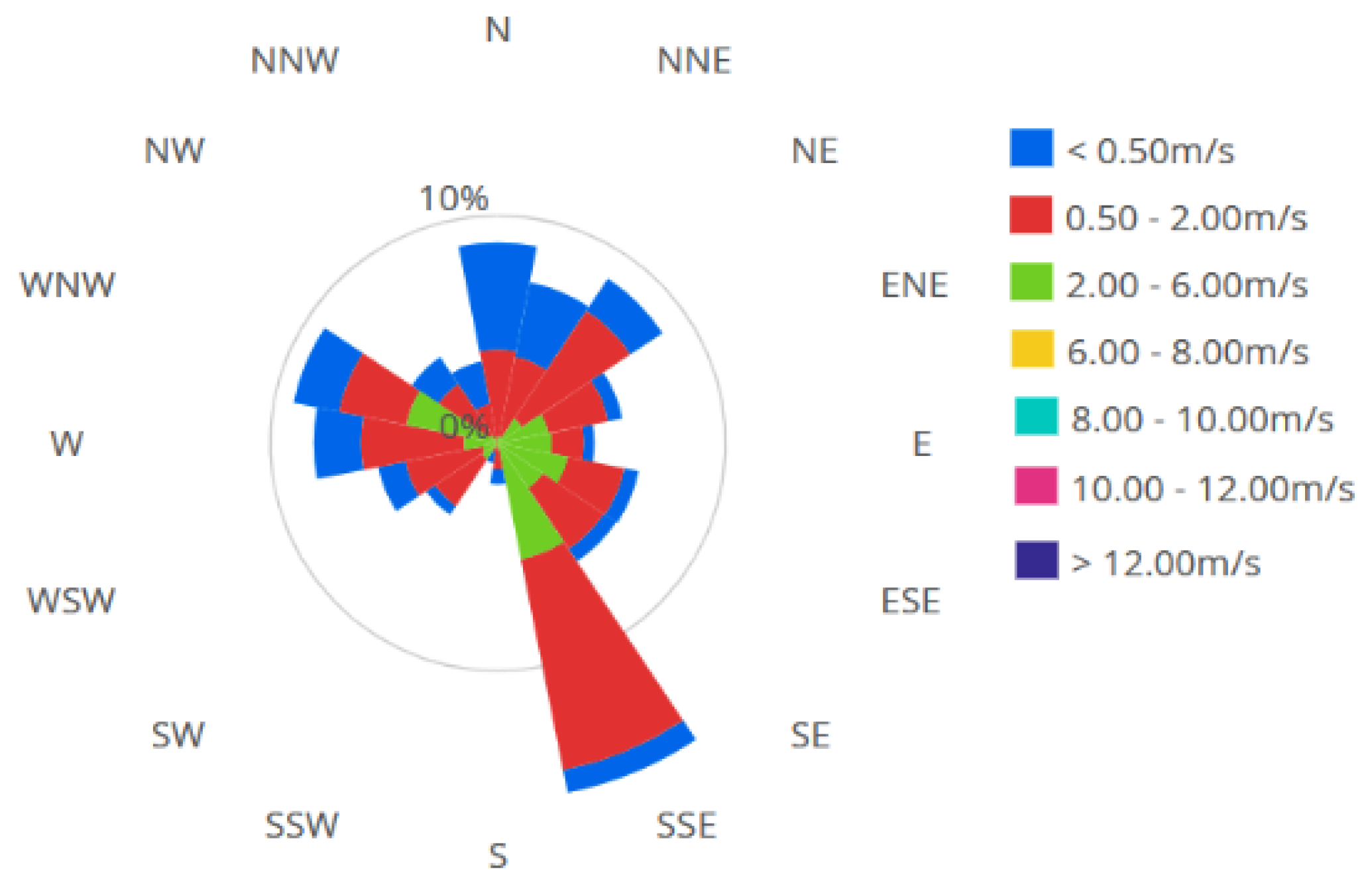
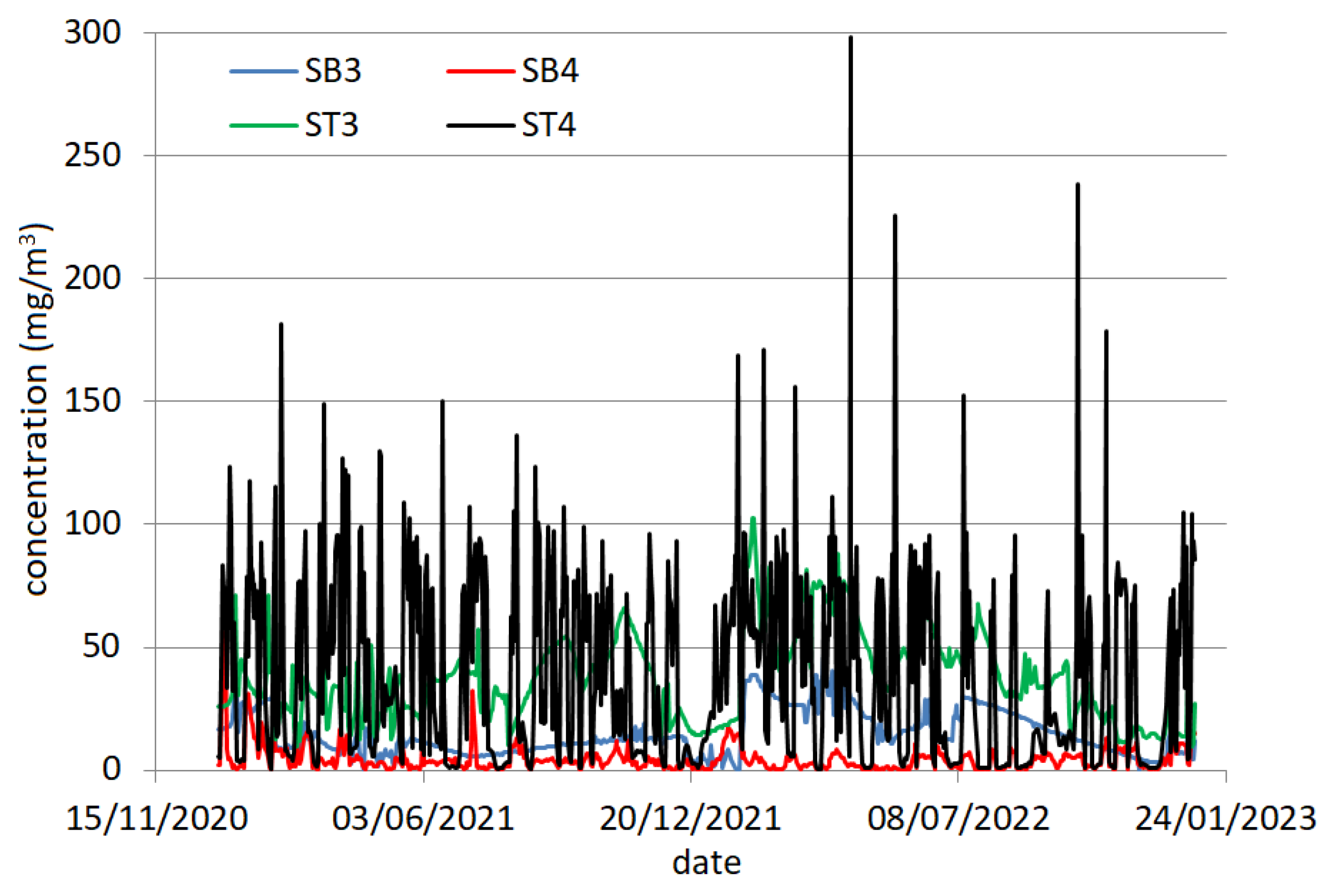

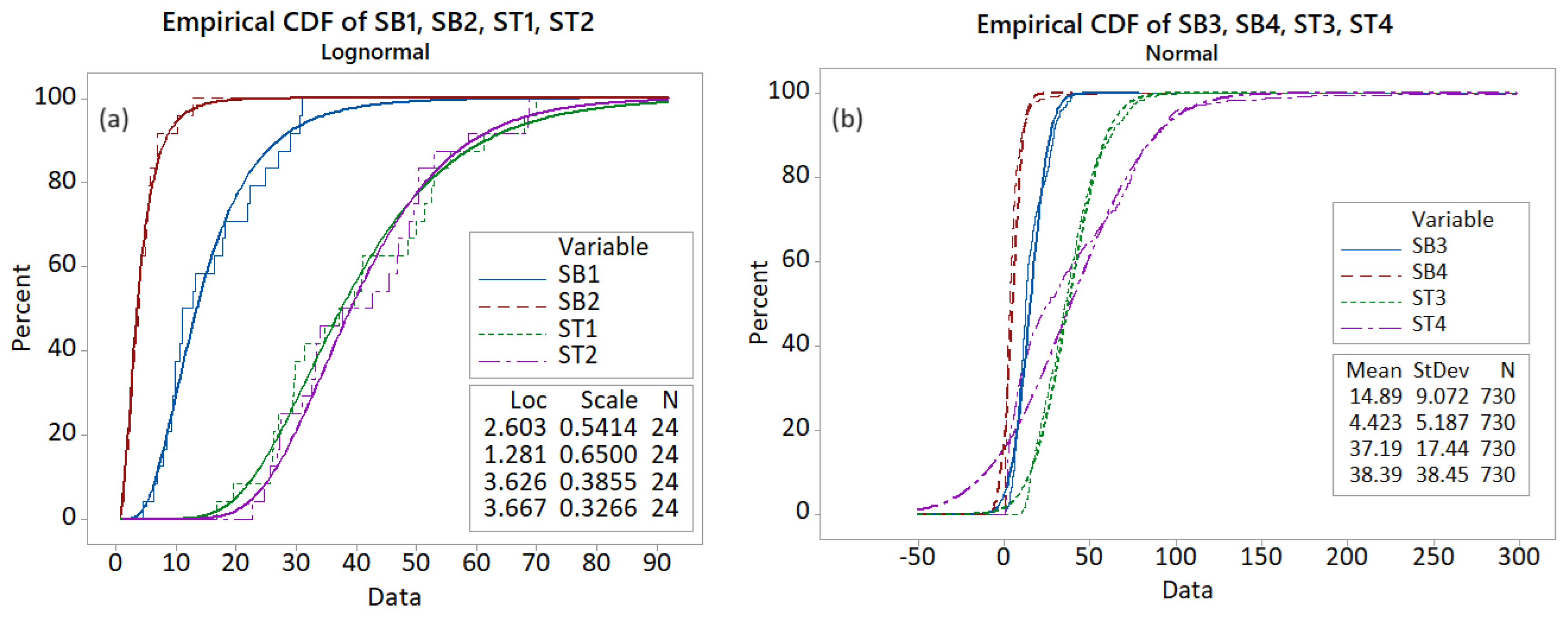
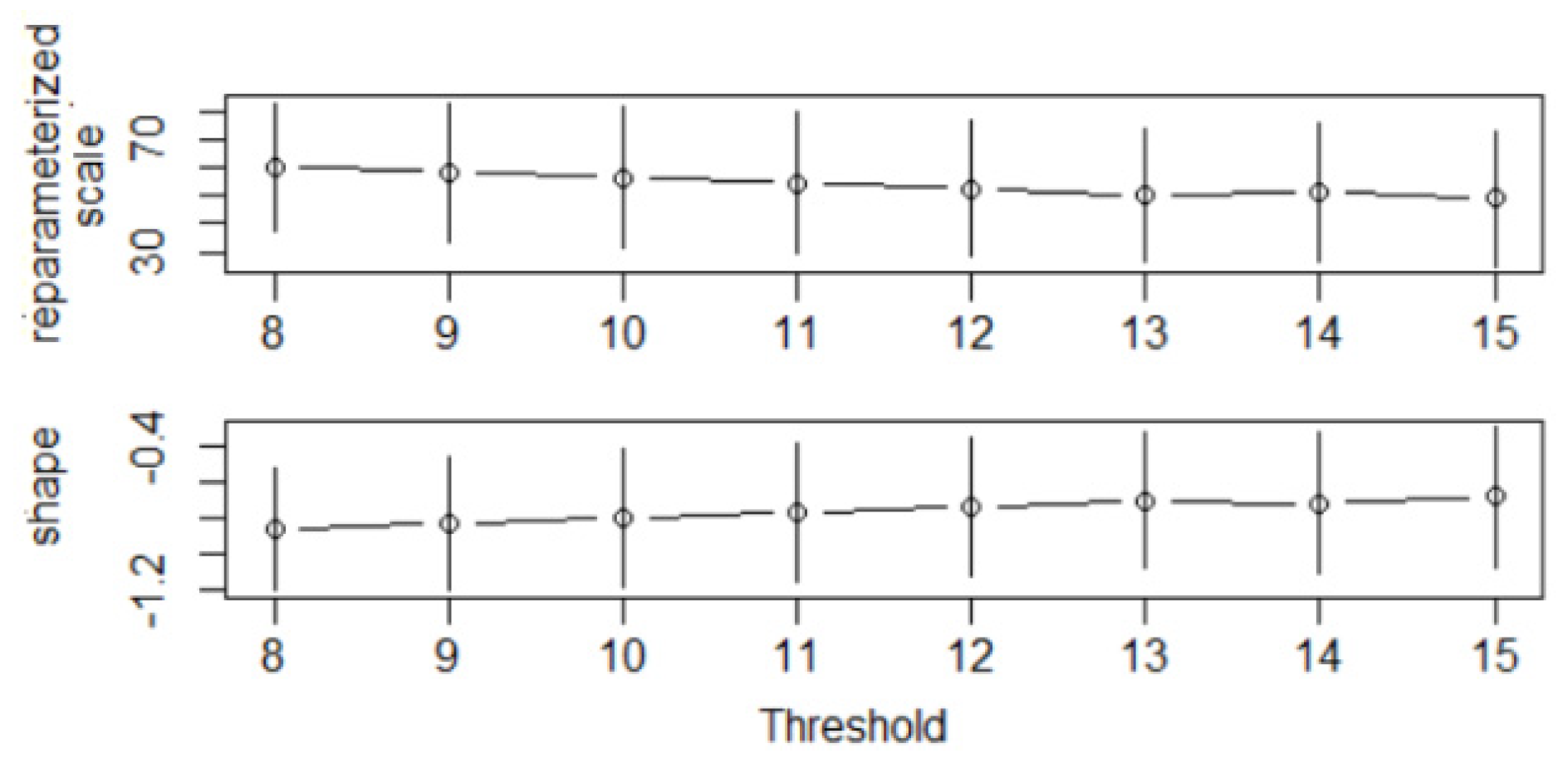
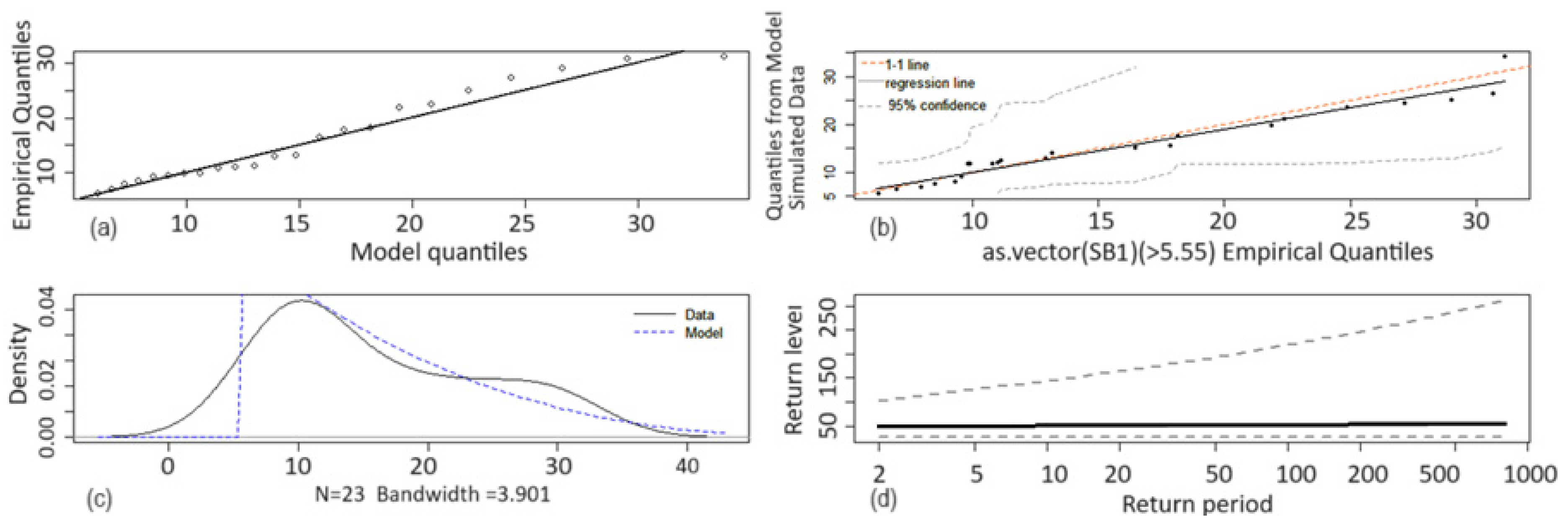

| VOC Species | (μg/m3) | (μg/m3)−1 | Percentage |
|---|---|---|---|
| benzene(C6H6) | 30 | 7.8 10−6 | 37.00 |
| toluene (C7H8) | 5000 | - | 14.00 |
| ethylbenzene (C8H10) | 1000 | 2.5 10−6 | 7.50 |
| styrene (C8H10) | 1000 | - | |
| m-,p-xylene (C8H10) | 100 | - | 8.30 |
| o-xylene (C8H10) | 100 | - | 1.80 |
| 1,2,3-trimethylbenzene (C9H12) | 60 | - | 3.00 |
| n-hexane (C6H14) | 700 | - | 28.00 |
| cyclohexane (C6H12) | 6000 | - | 0.10 |
| Statistics | SB1 | SB2 | SB3 | SB4 | ST1 | ST2 | ST3 | ST4 |
|---|---|---|---|---|---|---|---|---|
| mean | 15.50 | 4.36 | 14.89 | 4.42 | 40.26 | 41.16 | 37.19 | 38.39 |
| stdev | 8.27 | 2.84 | 9.07 | 5.19 | 14.96 | 13.43 | 17.44 | 38.54 |
| minimum | 4.61 | 0.80 | 0.00 | 0.00 | 16.80 | 22.84 | 9.78 | 0.42 |
| maximum | 31.13 | 12.96 | 48.45 | 56.00 | 69.97 | 68.87 | 102.76 | 298.58 |
| cv (%) | 53.35 | 65.13 | 60.92 | 117.28 | 37.17 | 32.63 | 46.88 | 101.15 |
| skewness | 0.69 | 1.52 | 0.84 | 3.69 | 0.43 | 0.53 | 0.69 | 1.47 |
| p-val | SB1 | SB2 | SB3 | SB4 | ST1 | ST2 | ST3 | ST4 |
|---|---|---|---|---|---|---|---|---|
| p-val AD | 0.0111 | 0.0207 | 0.0000 | 0.0000 | 0.2564 | 0.1450 | 0.0000 | 0.0000 |
| p-val FK | 0.0421 | 0.5093 | 0.0000 | 0.0000 | 0.1202 | 0.4720 | 0.0000 | 0.0001 |
| p-val MK/ (Sen’slope) | 0.0395/ (0.4775) | 0.0161/ (−0.1916) | 0.0013/ (0.0049) | 0.0040/ (−0.001) | 0.0106/ (1.2596) | 0.2059 | 0.4415 | 0.0000/ (−0.0151) |
| p-val KPSS-level | 0.0825 | 0.0464 | 0.0100 | 0.0100 | 0.0336 | 0.1000 | 0.0100 | 0.0407 |
| p-val KPSS-trend | 0.0691 | 0.0823 | 0.0100 | 0.0100 | 0.100 | 0.1000 | 0.0100 | 0.1000 |
| Series | Threshold | Return Period | |||||||
| 2 | 3 | 4 | 6 | 12 | 24 | ||||
| SB1 | 13.2525 | −0.2714 | 5.55 | 46.13 | 46.99 | 47.55 | 48.26 | 49.31 | 50.18 |
| SB2 | 2.7860 | 0.0005 | 5.55 | 20.09 | 21.22 | 22.02 | 23.16 | 25.09 | 27.03 |
| ST1 | 42.8420 | −0.7807 | 16.2 | 70.75 | 70.84 | 70.89 | 70.94 | 71.00 | 71.03 |
| ST2 | 39.9693 | −0.8323 | 19.35 | 67.18 | 67.23 | 67.26 | 67.30 | 67.33 | 67.35 |
| Series | Threshold | Return Period | |||||||
| 2 | 5 | 10 | 20 | 50 | 100 | ||||
| SB3 | 12.8678 | −0.2331 | 8 | 51.82 | 54.89 | 56.89 | 59.49 | 60.64 | 61.94 |
| SB4 | 3.7235 | 0.2069 | 4.25 | 43.61 | 55.59 | 66.28 | 78.62 | 97.90 | 115.12 |
| ST3 | 38.4456 | −0.6441 | 17.40 | 76.15 | 76.57 | 76.76 | 76.88 | 76.97 | 77.02 |
| ST4 | 71.4874 | −0.5441 | 15.00 | 141.54 | 143.44 | 144.36 | 145.00 | 145.54 | 145.81 |
| Species | Site | Health Index | Categ (1) | Categ (2) | Categ (3) | Categ (4) |
|---|---|---|---|---|---|---|
| Benzene | 1 | HI | 4.93 × 10−1 | 8.38 × 10−1 | 1.20 × 100 | 1.84 × 100 |
| LCR | 1.23 × 10−4 | 2.09 × 10−4 | 3.00 × 10−4 | 4.62 × 10−4 | ||
| 2 | HI | 1.70 × 100 | 2.89 × 100 | 4.15 × 100 | 6.39 × 100 | |
| LCR | 1.42 × 10−4 | 2.42 × 10−4 | 3.47 × 10−4 | 5.34 × 10−4 | ||
| TVOCs | 1 | HI | 3.13 × 10−2 | 5.33 × 10−2 | 7.64 × 10−2 | 1.17 × 10−1 |
| LCR | 8.38 × 10−5 | 1.42 × 10−4 | 2.04 × 10−4 | 3.14 × 10−4 | ||
| 2 | HI | 2.73 × 10−1 | 4.64 × 10−1 | 6.65 × 10−1 | 1.02 × 100 | |
| LCR | 2.43 × 10−4 | 4.14 × 10−4 | 5.93 × 10−4 | 9.13 × 10−4 |
Disclaimer/Publisher’s Note: The statements, opinions and data contained in all publications are solely those of the individual author(s) and contributor(s) and not of MDPI and/or the editor(s). MDPI and/or the editor(s) disclaim responsibility for any injury to people or property resulting from any ideas, methods, instructions or products referred to in the content. |
© 2024 by the authors. Licensee MDPI, Basel, Switzerland. This article is an open access article distributed under the terms and conditions of the Creative Commons Attribution (CC BY) license (https://creativecommons.org/licenses/by/4.0/).
Share and Cite
Barbeş, S.-B.; Bărbulescu, A.; Barbeș, L. Assessing Benzene and TVOC Pollution and the Carcinogenic and Noncarcinogenic Risks to Workers in an Industrial Plant in Southeastern Romania. Toxics 2024, 12, 187. https://doi.org/10.3390/toxics12030187
Barbeş S-B, Bărbulescu A, Barbeș L. Assessing Benzene and TVOC Pollution and the Carcinogenic and Noncarcinogenic Risks to Workers in an Industrial Plant in Southeastern Romania. Toxics. 2024; 12(3):187. https://doi.org/10.3390/toxics12030187
Chicago/Turabian StyleBarbeş, Sebastian-Barbu, Alina Bărbulescu, and Lucica Barbeș. 2024. "Assessing Benzene and TVOC Pollution and the Carcinogenic and Noncarcinogenic Risks to Workers in an Industrial Plant in Southeastern Romania" Toxics 12, no. 3: 187. https://doi.org/10.3390/toxics12030187
APA StyleBarbeş, S.-B., Bărbulescu, A., & Barbeș, L. (2024). Assessing Benzene and TVOC Pollution and the Carcinogenic and Noncarcinogenic Risks to Workers in an Industrial Plant in Southeastern Romania. Toxics, 12(3), 187. https://doi.org/10.3390/toxics12030187








